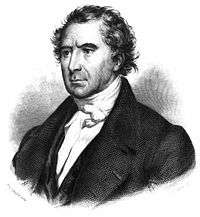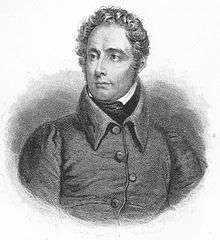French Executive Commission (1848)
| Executive Commission of 1848 | |
|---|---|
|
cabinet of France | |
|
| |
| Date formed | 9 May 1848 |
| Date dissolved | 24 June 1848 |
| People and organisations | |
| Head of government | François Arago |
| Head of state | Executive Commission members |
| History | |
| Predecessor |
Provisional Government of 1848, Jacques-Charles Dupont de l'Eure |
| Successor |
Cabinet of General Cavaignac, Louis-Eugène Cavaignac |
The Executive Commission of 1848 was a short-lived government during the French Second Republic, chaired by François Arago, that exercised executive power from 9 May 1848 to 24 June 1848. It succeeded the Provisional Government of 1848 and was in turn replaced by the Cabinet of General Cavaignac. The members of the Commission acted as joint head of state.
The Commission lacked support in the National Assembly. It soon found itself at odds with the conservative majority and effectively unable to properly govern. The closure of the National Workshops, by leading to the June Days Uprising, sealed the doom of the Executive Commission. Judging the Commission unable to quell the uprising, the Assembly effectively dissolved it on June 24 by a vote of no confidence and gave full powers to General Louis Eugène Cavaignac.
Formation
In May 1848 the National Assembly decided to establish the Executive Commission as a form of collective presidency, similar to that of Year III in the first French Revolution. The members were chosen from prominent members of the former Provisional Government.[1] The members named to the commission by the Assembly on 9 May 1848 were François Arago (President of the Commission), Alphonse de Lamartine, Louis-Antoine Garnier-Pagès, Alexandre Auguste Ledru-Rollin and Pierre Marie de Saint-Georges.[2] These members acted jointly as head of state.[3]
Lamartine was seen by many as representing order and respect for property, while Ledru-Rollin stood for violence and communism. However, Lamartine used his strong popular mandate to force the National Assembly to make Ledru-Rollin one of the members of the Executive Commission. This greatly undermined his credibility.[4] Lamartine's motives are unclear, but perhaps he was concerned that the power was swinging too far towards the Conservatives.[2]
The members of the Executive Commission were not assigned ministries. Instead, at the first meeting on 11 May 1848 the commission appointed ministers. They were all moderate republicans apart from Ferdinand Flocon. The composition of the government was thus unsatisfactory to both the conservative majority of the National Assembly and the radical left.[4]
Events
Demonstration of 15 May
At this time the bourgeoisie were becoming increasingly uneasy about the possibility of mob rule leading to a repeat of the Reign of Terror of the first French Revolution. Ledru-Rollin planned a fête de la Concorde on 15 May celebrating peace and labor that included decorations that recalled the earlier revolution.[5] On 13 May the Executive Commission, nervous about rumors of planned demonstrations, announced that the festival was postponed. The move backfired. A crowd led by Louis Auguste Blanqui launched an attack on 15 May on the Palais Bourbon, where the Assembly was meeting.[6] The head of the National Guard of Paris, General Amable de Courtais, would not order his men to use violence.[7] For three hours the Assembly was paralyzed by the demonstrators.[8]
Order was restored, but the authority of the Commission was damaged.[6] The conservative majority in the Assembly blamed the Executive Committee for allowing the incident to occur, saying it was not competent.[9] The arrest of the leaders of the workers, Armand Barbès and Blanqui, left the working people without leaders.[10] General Coutais was also arrested, accused of treason.[7] The government reorganized the National Guard and moved a large garrison of regular army troops into the center of Paris. On 22 May 1848 the Executive Commission dissolved the Club Raspail and the Club Blanqui, left-wing bases.[9]
Issue of Louis Napoleon
Louis Napoleon, who was in exile in London, was elected to the National Assembly on 4 June 1848. He was known to be ambitious to take supreme power, and had already made two failed attempts, in 1836 and 1840.[11] A circular appeared in the departments on 16 June 1848 in which the Executive Government ordered the arrest of Louis Napoleon. It appears to have been issued just before the question was raised in the National Assembly, and indicates that the government was confident that the motion would pass.[12] On 13 June Lamartine and Ledru-Rollin argued in the Assembly that Louis-Napoleon be disqualified, but the majority voted to admit him. In the event, Louis-Napoleon sent a letter of resignation, but his plans remained unclear.[11] This was another of the steps that weakened the government and led to its fall.[13]
June Days
National Workshops had been established by decree of the Provisional Government in February 1848 with the objective of providing employment through undertaking public works. They employed thousands of men during the spring of 1848, doing jobs like leveling and ditching.[14] The National Assembly placed increasing pressure on the Commission to close down the workshops.[15] When the Executive Commission announced their effective closure on 21 June 1848 this pushed an already discontented proletariat into open rebellion.[16]
According to the Bien Public, the committee anticipated the June Days Uprising (23–26 June 1848) and ordered General Louis-Eugène Cavaignac to concentrate forty or fifty thousand men in Paris so he could suppress the riots without bloodshed. However, when the riots began on the morning of Friday 23 June there were only ten to twelve thousand troops in the city.[17] Cavaignac insisted on letting the workers build their barricades without opposition, so they could be more effectively destroyed, where Lamartine and others argued for taking immediate action to avoid bloodshed. Cavaignac's views prevailed.[18]
On Saturday 24 June 1848 the Assembly decided to remove the Executive Commission from power and install Cavaignac as dictator.[19] At the insistence of the Assembly the five members of the Executive Commission resigned on that day. This ended the political careers of Lamartine and Ledru-Rollin.[20] Once Cavaignac had been granted full power, more troops appeared and the uprising was quickly suppressed.[21]
Ministers
The ministerial appointments were:[4]
| Ministry | Start | End | Minister | Sub-secretary of State |
|---|---|---|---|---|
| Interior | 11 May 1848 | 28 June 1848 | Adrien Recurt | Nicolas Henri Carteret |
| Foreign Affairs | 11 May 1848 | 28 June 1848 | Jules Bastide | Jules Favre |
| Finance | 11 May 1848 | 28 June 1848 | Charles Duclerc | |
| Justice | 11 May 1848 | 7 June 1848 | Adolphe Crémieux | |
| Justice | 7 June 1848 | 28 June 1848 | Eugène Bethmont | |
| Public Works | 11 May 1848 | 28 June 1848 | Ulysse Trélat | |
| Agriculture and Commerce | 11 May 1848 | 28 June 1848 | Ferdinand Flocon | |
| Religious Affairs | 11 May 1848 | 28 June 1848 | Eugène Bethmont | |
| Public Education | 11 May 1848 | 28 June 1848 | Hippolyte Carnot | Jean Reynaud |
| War | 11 May 1848 | 17 May 1848 | Jean-Baptiste-Adolphe Charras | |
| War | 17 May 1848 | 28 June 1848 | Louis-Eugène Cavaignac | |
| Navy and Colonies | 11 May 1848 | 28 June 1848 | Joseph Grégoire Casy | Raymond de Verninac Saint-Maur (from 7 June 1848) |
References
- ↑ Agulhon 1983, p. 50.
- 1 2 Robertson 1952, p. 79.
- ↑ Fortescue 2004, p. 101.
- 1 2 3 Fortescue 2004, p. 102.
- ↑ Plotek 2008, p. 115.
- 1 2 Plotek 2008, p. 119.
- 1 2 Robert & Cougny 1889, p. 205.
- ↑ Fortescue 2004, p. 103.
- 1 2 Fortescue 2004, p. 104.
- ↑ Robertson 1952, p. 83.
- 1 2 Agulhon 1983, p. 55.
- ↑ Chamier 1849, p. 36.
- ↑ Chamier 1849, p. 37.
- ↑ Sewell 1980, p. 246.
- ↑ Agulhon 1983, p. 56.
- ↑ Sewell 1980, p. 272.
- ↑ Chamier 1849, p. 247.
- ↑ Robertson 1952, p. 89.
- ↑ Robertson 1952, p. 93.
- ↑ Agulhon 1983, p. 60.
- ↑ Chamier 1849, p. 248.
Sources
- Agulhon, Maurice (1 September 1983). The Republican Experiment, 1848-1852. Cambridge University Press. ISBN 978-0-521-28988-7. Retrieved 19 March 2014.
- Chamier, Frederick (1849). A review of the French revolution of 1848: from the 24th of February to the election of the first president. Reeve, Benham, and Reeve. Retrieved 19 March 2014.
- Fortescue, William (2 August 2004). France and 1848: The End of Monarchy. Routledge. ISBN 978-1-134-37923-1. Retrieved 19 March 2014.
- Plotek, Ariel (2008). Allegory in the Age of Realism: Monumental Sculpture in France, 1848—1880. ProQuest. ISBN 978-0-549-75004-8. Retrieved 19 March 2014.
- Robertson, Priscilla Smith (1952). Revolutions of 1848: A Social History. Princeton University Press. ISBN 0-691-00756-X. Retrieved 19 March 2014.
- Robert, Adolphe; Cougny, Gaston (1889). "COURTAIS (Amable-Gaspard-Henri, vicomte de)". Dictionnaire des Parlementaires français de 1789 à 1889 (PDF). 2. Retrieved 2014-03-16.
- Sewell, William Hamilton (31 October 1980). Work and Revolution in France: The Language of Labor from the Old Regime to 1848. Cambridge University Press. ISBN 978-0-521-29951-0. Retrieved 19 March 2014.


